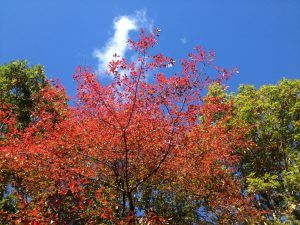No matter how many autumns I’ve seen, I never tire of watching the trees transform from an undefined backdrop of green to a diverse group of colorful individuals. The colors are not only breathtaking – they become our key to identifying particular trees. The dark, cool wooded spaces we’ve been driving past all summer are lit up, filled with color and visible to us in a whole new way. The mass of summer-green foliage along my street has become a brilliantly differentiated array of purple-red black gums, golden yellow birches, evergreen cedars and glossy green sweet bay magnolia. 
While I’ve enjoyed this yearly phenomenon for as long as I can remember, it was only a few years ago that I learned what really happens when leaves “change” color. Leaves change color in the fall when temperatures are cooler, so we assume that cooler temperatures have caused the transformation. In fact, leaves don’t require cold temperatures to begin to change color. As summer wanes, it’s the decrease in the daylight that actually triggers the change. During the growing season, trees are actively producing the pigment chlorophyll. Chlorophyll absorbs from sunlight the energy required to turn water and carbon dioxide into the simple sugars that make plants grow. Even though the chlorophyll is continuously used, it’s also replenished in such great amounts that it becomes the predominant pigment and the leaves appear to be green.
There are other pigments also present in the leaves, however, called carotenoids and xanthophylls that just aren’t visible in the presence of a lot of chlorophyll. As days shorten, nights lengthen and summer wanes, the chlorophyll is replaced more slowly than it is used. As it dwindles, the other pigments are revealed! It’s then that the xanthophylls and carotenoids give us the many shades of yellow, orange and brown that we see in the fall.
Reds and purples are produced by a third group of pigments called anthocyanins. Anthocyanins aren’t present all season, like carotenoids and xanthophylls. They develop as sugars break down in the presence of bright light and decreasing phosphate levels. During the growing season, phosphate levels are high because phosphate is vital to use the sugars made by the chlorophyll. As phosphates begin to move out of the leaf and into the stem, however, fewer sugars are used and anthocyanin pigments are formed. The brighter the light at this time, the more excess sugars there will be, the higher the anthocyanin levels will be and the brighter the colors will be! Not only do freezing nighttime temperatures not initiate the color change, they actually weaken the colors and hasten the browning of the leaves.
Soil moisture levels also affect leaf color. A severe summer drought can delay the arrival of autumn color by several weeks and warm, wet fall weather can weaken color intensity. A warm wet spring, followed by average amounts of summer rainfall and warm sunny autumn days paired with cool (but not freezing) nights, is the perfect prescription for a brilliant fall.
As autumn days cool and we enjoy more and more color, we can also begin to spot quite an assortment of trees. In our region, we’re likely to see yellow leaves on ash, birch, poplar, redbud, serviceberry, willow and some species of maple. Oranges are rarer and occur on some species of oak and maple. The deepest reds are carried by dogwoods, black gums, sweet gums, red maples and scarlet or northern red oaks. Sumac, sassafras, wild blueberries and Virginia creeper also add some fabulous fire to South Jersey’s understory.
Remember, as you travel along our roadways on an autumn afternoon, to bask in the sunlit leaves of yellow, orange and red. One breath of frost, one blustery breeze and they’ll be gone before we know it.